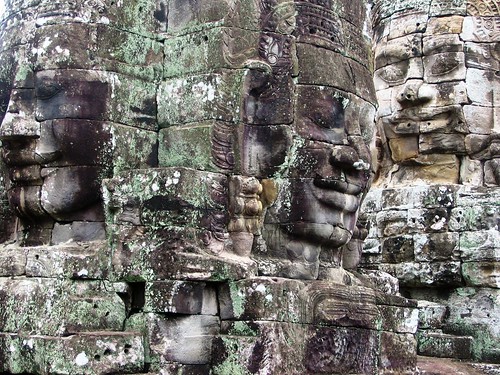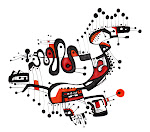The Bayon is a well-known and richly decorated Khmer temple at Angkor in Cambodia. Built in the late 12th century or early 13th century as the official state temple of the Mahayana Buddhist King Jayavarman VII, the Bayon stands at the centre of Jayavarman's capital, Angkor Thom. Following Jayavarman's death, it was modified and augmented by later Hindu and Theravada Buddhist kings in accordance with their own religious preferences.
The Bayon's most distinctive feature is the multitude of serene and massive stone faces on the many towers which jut out from the upper terrace and cluster around its central peak. The temple is known also for two impressive sets of bas-reliefs, which present an unusual combination of mythological, historical, and mundane scenes. The main current conservatory body, the JSA, has described the temple as "the most striking expression of the 'baroque' style" of Khmer architecture, as contrasted with the 'classical' style of Angkor Wat.The inner gallery is nearly filled by the upper terrace, raised one level higher again. The lack of space between the inner gallery and the upper terrace has led scholars to conclude that the upper terrace did not figure in the original plan for the temple, but that it was added shortly thereafter following a change in design. Originally, it is believed, the Bayon had been designed as a single-level structure, similar in that respect to the roughly contemporaneous foundations at Ta Prohm and Banteay Kdei.
The upper terrace is home to the famous "face towers" of the Bayon, each of which supports two, three or (most commonly) four gigantic smiling faces. In addition to the mass of the central tower, smaller towers are located along the inner gallery (at the corners and entrances), and on chapels on the upper terrace. "Wherever one wanders," writes Maurice Glaize, the faces of Lokesvara follow and dominate with their multiple presence."
Efforts to read some significance into the numbers of towers and faces have run up against the circumstance that these numbers have not remained constant over time, as towers have been added through construction and lost to attrition. At one point, the temple was host to 49 such towers; now only 37 remain. The number of faces is approximately 200, but since some are only partially preserved there can be no definitive count.
http://en.wikipedia.org/wiki/Bayon




